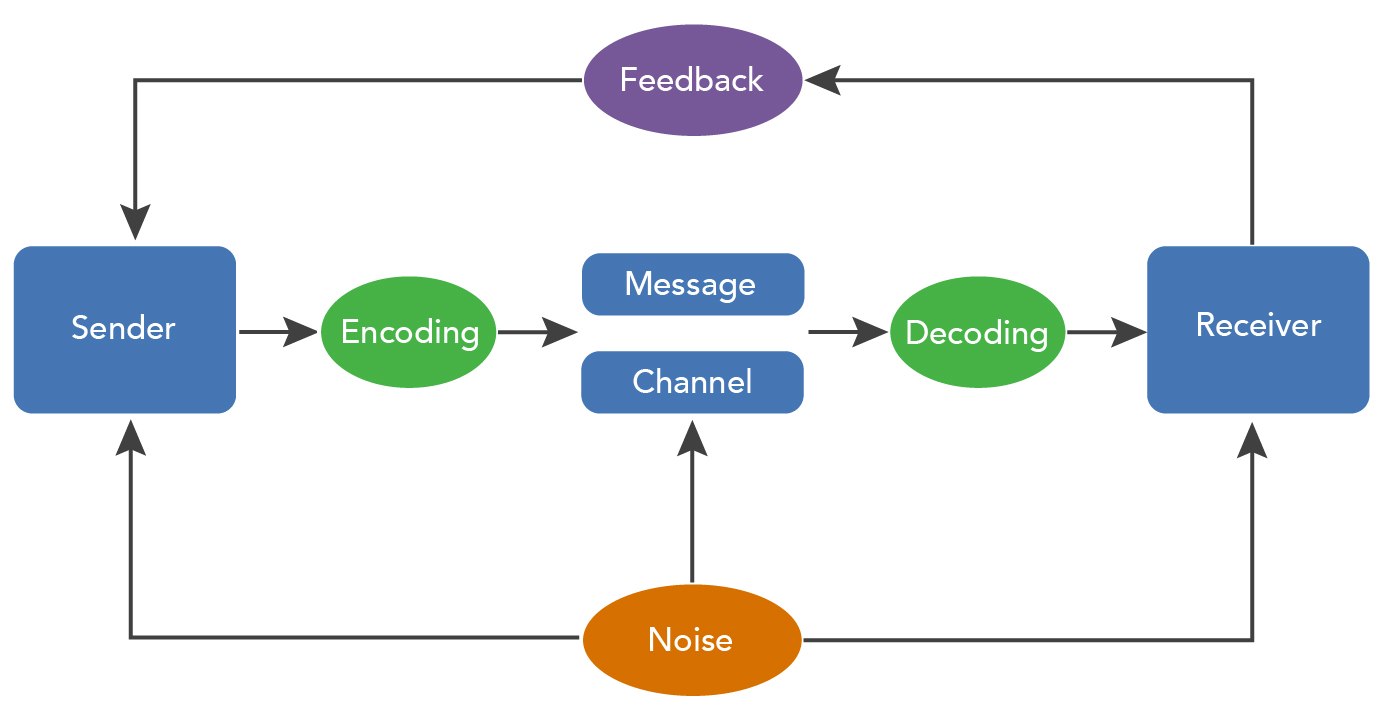Learning Outcomes
- Describe the communication process
What does communication look like? When you think about communication in its simplest form, the process is really quite linear. There’s a sender of a message—let’s say you—talking. You, the sender, have a thought. You put that thought into words, which is encoding the message.
And then there’s a recipient of a message—in this case your coworker Nikola. The message comes out of your mouth, and then it is decoded, or processed, by the recipient, Nikola, who then decides on the meaning of your words as a result of that decoding process. She hears your words and considers their meaning—put simply, she’s listening. It looks something like this:

But what the sender says isn’t always what the reciever hears. Encoding and decoding don’t always happen seamlessly. In this instance, Nikola might “tune out” and miss some of what you said, or she may hear your words correctly, but misunderstand their meaning. It may even be a concept that is doomed to be misunderstood before your words are even formed, due to existing difference between you and your coworker. When this happens, it’s called noise.

If Nikola is not clear on your message, she may stop you and say, “Wait. You’re saying this. Do I understand you correctly?” This is called feedback.

Your recipient has let you know that you’ve been misunderstood by giving you feedback. At this point you can
- Repeat the message a second time
- Ask some clarifying questions to determine why your recipient didn’t understand what you said, and then address those issues on your next attempt to communicate your idea.
Feedback can come in a variety of forms, too. In this case, Nikola is repeating your statement and asking for confirmation that she heard it correctly. In another case, you may have told Nikola that to find the restroom she needs to head down a hall and turn right. When she heads down the hall and turns left, that, too, is feedback letting you know you’ve been misunderstood.
Often that’s the kind of feedback an organization has to navigate. Organizations issue a communication, perhaps in the form of a memo, and send it out to all their employees. Employees read it. If the message is understood and appropriate actions are taken, all is well. There may have been noise, but it did not get in the way of the message. If employees start firing emails back to the originator of the message, asking questions or clarifying points, they are engaging in feedback. If they take action that is not appropriate, that’s also feedback. The message needs to be reiterated, framed differently, to clarify portions that were not communicated the first time.
This whole process, the steps between a source and receiver that result in the transference and understanding of meaning, is called the communication feedback loop. In an organizational communication feedback loop, we can also consider the channel of communication in the message. The channel is the medium by which the message travels. Newsletters, one-on-one meetings, town halls, video conferencing—all of these are channels of communication.

Practice Question
There are formal channels of communication in an organization. These are channels of communication established by an organization to transmit messages that impact the work-related activities of its employees. They can follow the authority chain in an organization, and would include things like messages from leadership, information from the human resources department about benefits, or even articles recognizing an employee for great work.
The informal channels of communication in an organization are personal and social. Your mind may automatically go to “water cooler gossip” and, while that is definitely an informal channel of communication, there are plenty of ways informal communication channels do an organization good. For instance, a new process may be in the testing phase with a group of employees. Those employees can iron out the wrinkles of the process and become enthused about it, acting as ambassadors for the new method with other employees before it’s even rolled out. The informal channel, in this example, is communication that will assist with change management.
By understanding the goals of communication and how communication operates, an organization can ensure their employees have the right information to do their jobs, and ultimately open the door to increased engagement and productivity.
Candela Citations
- The Process of Communication. Authored by: Freedom Learning Group. Provided by: Lumen Learning. License: CC BY: Attribution
- Images: Communication Process. Authored by: Freedom Learning Group. Provided by: Lumen Learning. License: CC BY: Attribution
